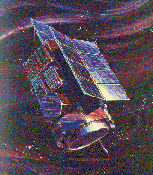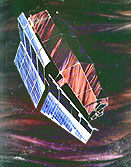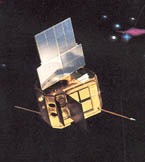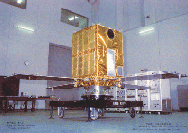The History of X-ray Astronomy:
Moving Toward the Modern Era
X-ray astronomy excelled during the 1980s and 1990s with a string of world-class X-ray observatories constructed and operated by scientists in Europe and Japan, although with U.S. collaboration.
The U.S.-led HEAO-1 and HEAO-2 satellites, launched in 1977 and 1978 respectively, were the springboards for these larger missions. HEAO-1 surveyed the higher-energy X-ray sky; and HEAO-2, commonly known as the Einstein Observatory, surveyed the lower-energy X-ray sky. This provided astronomers with a firm foundation of what types of X-ray sources existed. Over the next two decades, astronomers zoomed in to study with greater scrutiny what the HEAO sisters recorded.
Astronomers needed two dedicated satellites to capture the full range of X-ray energies that the universe has to offer, for the section of the electromagnetic spectrum we call X rays is very broad. Our eyes detect visible, or optical, wavelengths. So too do many of the giant telescopes on dark, lonely mountaintops on earth. Visible light constitutes a very small section of the electromagnetic spectrum. Our eyes, a "visible light detecting instrument," can capture this entire section of the spectrum at once, taking it all in. We cannot detect radio, infrared, ultraviolet, X-ray and gamma-ray wavelengths.
The X ray bandwidth, far more energetic than visible light, is about seven times wider in terms of energy range. (Visible light has a frequency of about 1015 hertz; X rays stretch from 1016 to 1020 hertz.) So, one instrument or one satellite cannot cover the entire X-ray regime.
EXOSAT, built by the European Space Agency and launched in 1983, zoomed in on the higher-energy part of the X-ray spectrum. One major discovery from this mission was quasi-periodic oscillations, or flickering, from neutron stars and black holes. By 2002, astronomers finally had solid evidence that these oscillations are a direct measure of the neutron star and black hole spin rate. In all, EXOSAT made 1,780 observations of a wide variety of objects, including active galactic nuclei, stellar coronae, cataclysmic variables, white dwarfs, X-ray binaries, clusters of galaxies, and supernova remnants. The known X-ray universe was growing.
Japanese scientists launched Ginga in 1987, with U.S. participation. Ginga, the Japanese word for "galaxy," was the third and largest Japanese X-ray mission, originally named Astro-C. (Astro-D would launch in a few more years, and Astro-E is planned for 2005.) Ginga took us ever closer to a black hole, albeit virtually. Ginga discovered transient black hole candidates and studied their spectra evolution while these objects unpredictably turned on and off with an outpouring of high-energy X-ray radiation. Ginga also detected iron line emission from galactic cores, at the 6 to 7 kilo-electron-volt energy range, which later missions would explore as a test of general relativity around a black hole.
ROSAT, the German/UK-led Roentgensatellite, was a premiere imaging telescope of lower-energy X rays, of the type that the Einstein Observatory first detected. ROSAT was launched in 1990, and for the first time, astronomers had high-quality images of X-ray sources. ROSAT expanded the number of known X-ray sources to 125,000 and proved to be especially valuable in investigating the multi-million degree gas present in the upper atmospheres of many stars and in between stars and galaxies. Hot, free-floating gas glowing in X rays is a probe of dark matter, for it's the gravity or presence of this mysterious dark matter that attracts and heats the X-ray-emitting gas (ordinary matter).
ROSAT also made the first detection of X-ray radiation from the hot surface of a neutron star, and from comets. ROSAT resolved 70 percent of soft X-ray background and made an extensive catalogue of galaxy clusters. The field of X-ray astronomy was really bustling by this point.
ROSAT reigned for nearly nine years. Its first six months were dedicated to an all sky-survey -- the first X-ray all-sky survey using an imaging telescope with an X-ray sensitivity about 1,000 times better than that of Uhuru. In 1993, Japanese scientists launched Astro-D, commonly known as ASCA. This mission complemented ROSAT's imaging capability with spectral observations of sources emitting X rays often of a slightly higher energy.
ASCA, too, had a long life, lasting until July 2000. ASCA was the first mission to employ nested gold-coated foil mirrors that greatly improved X-ray photon collecting efficiency. This technology would become a standard for future missions. ASCA found the first evidence of the gravitational redshift due to the strong gravitational field around a black hole, the "broad iron K line" that Ginga first pointed to. ASCA also detected cosmic-ray electrons racing away from a supernova, the first observational evidence that star explosions are the source of at least some cosmic rays.
The Europeans charged forward with another superb X-ray observatory launched in 1996, the Italian-Dutch BeppoSAX. BeppoSAX was startling its coverage, collecting X-ray photons spanning three decades of energy, from 0.1 to 300 kilo-electron volts. The observatory had moderate imaging capability, too, but was primed for producing high-quality spectra. One of the key BeppoSAX discoveries was that of gamma-ray burst afterglows. Gamma-ray bursts are the most powerful explosions known in the universe, yet they fade within a few seconds, too quickly to study. Discovery of an afterglow meant scientists could, for the first time, observe the location of the burst and obtain a distance measurement. Indeed, as a result of BeppoSAX, we now know that gamma-ray bursts occurs billions of light years away, likely in early star-forming regions.
The BeppoSAX mission came to a close in April 2002. Today, astronomers are blessed with three major X-ray observatories: The Rossi X-ray Timing Explorer, the Chandra X-ray Observatory, and the XMM-Newton satellite. NASA's Rossi Explorer was actually launched a few months before BeppoSAX. Yet this satellite continues to make major observations, particularly of the funky physics of Einstein's general relativity around neutron stars and black holes.
40th Anniversary Articles
- Introduction
- The Rough and Tumble Early Days
- Moving Toward the Modern Era
- The X-ray Universe Today
- Forty Years from Today









